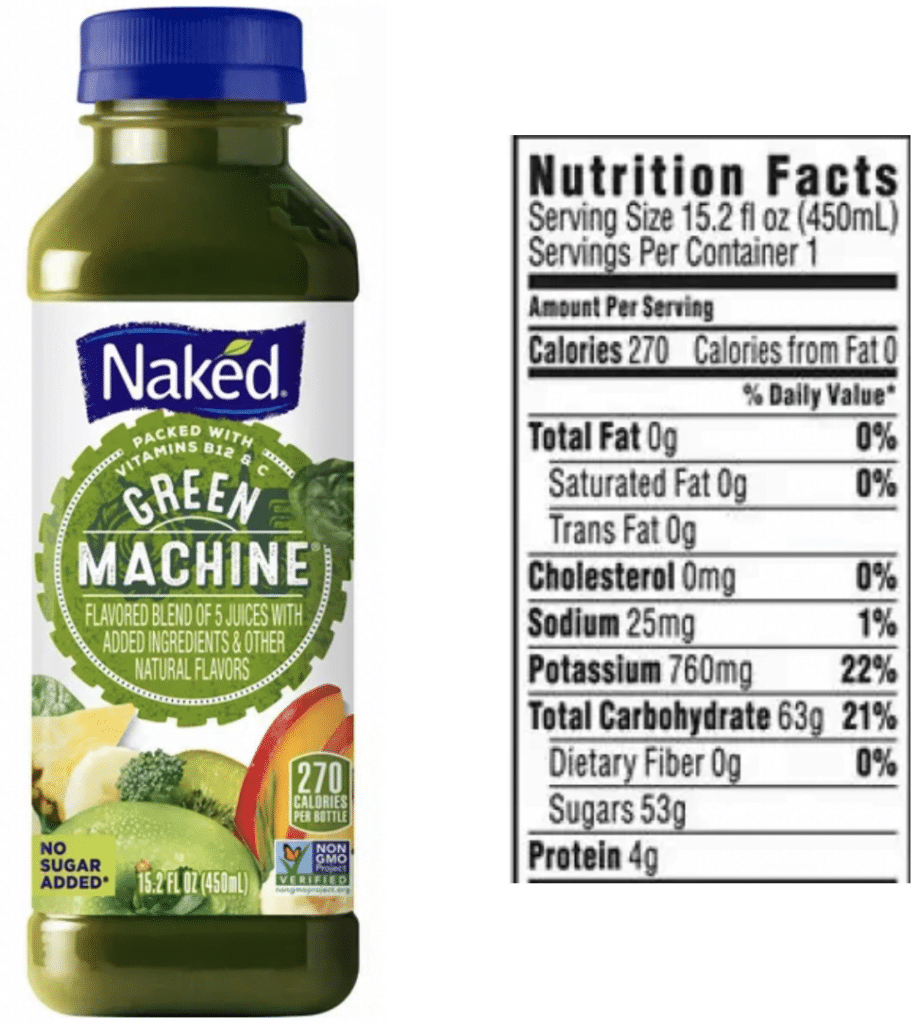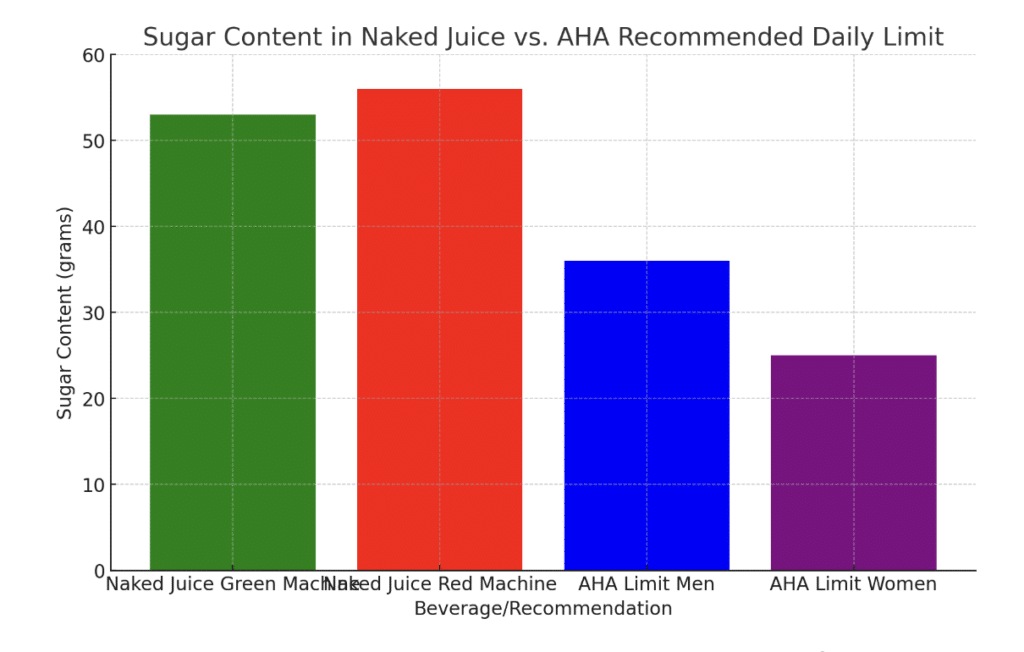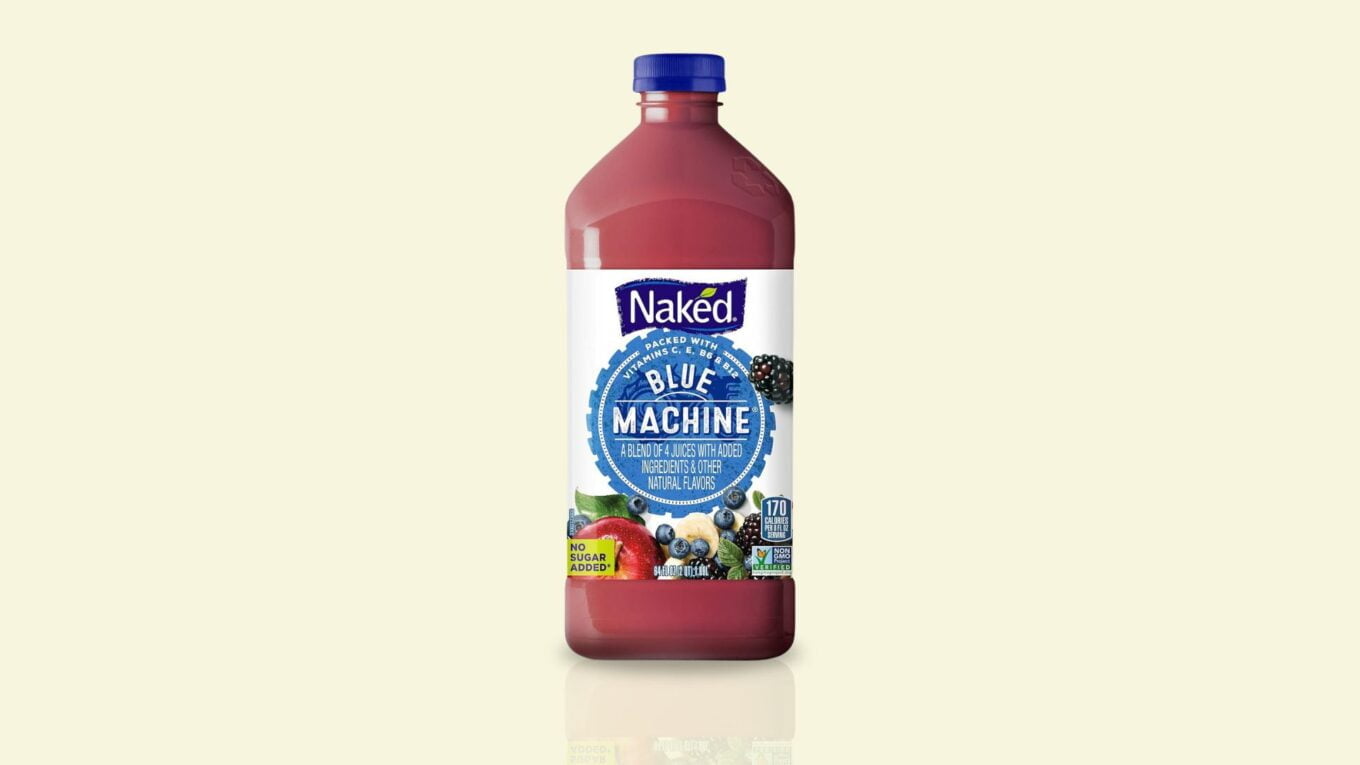Many individuals turn to Naked Juice, believing it to be a healthier alternative to sugary beverages due to its fruit and vegetable content.
However, the true nutritional value of Naked Juice has been a subject of debate, with concerns raised about its high sugar levels and questionable additives.
Understanding what goes into these popular beverages is crucial for making informed choices about our dietary intake.
In this comprehensive analysis, we will delve into the ingredients of Naked Juice, separating fact from fiction and empowering you to make educated decisions about incorporating these drinks into your lifestyle.
Product Analysis: What’s Inside Naked Juice?
| Beverage | Size (oz) | Calories | Carbohydrates (g) | Sugar (g) | Fiber (g) | Protein (g) |
|---|---|---|---|---|---|---|
| Naked Juice Green Machine | 15.2 | 270 | 63 | 53 | 1.3 | 4 |
| Naked Juice Red Machine | 15.2 | 320 | 76 | (assumed similar to Green) 56+ | 1.4 | 3 |
Based on its ingredients, the sugar content of Red Machine is assumed to be slightly higher than that of Green Machine; (actual values may vary and should be verified.)
Naked Juice prides itself on being made from a blend of fruits and vegetables sans preservatives, added sugars, and artificial flavors.
While this may seem like a healthy choice, it’s essential to understand the specific ingredients and their proportions in these beverages.
Some of Naked Juice’s popular variants include:
- Green Machine: A mix of fruits like apple, banana, and pineapple, combined with vegetables like spirulina and wheatgrass, intended to provide a nutrient-rich boost.
- Red Machine: This variant features antioxidant-rich berries like strawberries, raspberries and fruits like bananas and oranges to offer a fruity yet nutritious drink.
Detailed Nutritional Breakdown Of Naked Juice

1. Macronutrients
To fully grasp the impact of Naked Juice on your daily dietary needs, let’s examine the macronutrient content:
- Green Machine (15.2 oz): 270 calories, 63g carbs (53g sugar), 1.3g fiber, 4g protein
- Red Machine (15.2 oz): 320 calories, 76g carbs, 1.4g fiber, 3g protein
Compared to recommended daily guidelines, a single bottle of Naked Juice can significantly increase one’s daily sugar intake while providing minimal fiber.
2. Vitamins and Minerals
While Naked Juice does offer some essential vitamins and minerals, it’s important to understand their quantities and impact on overall health:
- Green Machine provides 50% of the Daily Value (DV) for Vitamin C, supporting immune function, and 25% for Vitamins A, B2, and B6, which play roles in vision, energy metabolism, and more.
- Depending on their specific ingredient blends, other variants may contain varying levels of these and other nutrients.
Ingredient Analysis by Variant: Green or Red?
1. Green Machine
- This variant primarily consists of apple juice combined with smaller amounts of banana puree, pineapple juice, and vegetable concentrates like spirulina and wheatgrass.
- While marketed as a nutrient-rich option, fruit juices’ high sugar content may negate some of their intended benefits.
2. Red Machine
- This variant features a blend of apple juice, banana puree, and various berry concentrates, such as strawberry and raspberry, which aim to provide antioxidant benefits.
- However, it’s essential to consider the overall sugar and calorie content, which can be substantial.
Sugar Content in Naked Juice vs. AHA Recommendation

What to Choose?
While Naked Juice can offer a convenient way to increase fruit and vegetable intake, it’s crucial to approach these beverages with moderation due to their high sugar content and potential impact on overall nutrition.
Due to the high natural sugar levels, it may be advisable to limit or avoid naked juice for individuals looking to manage conditions like diabetes or weight.
However, for those seeking a quick nutrient boost, these juices could be an occasional supplement when consumed mindfully and in moderation.
Ultimately, prioritizing whole fruits and vegetables is generally recommended for optimal nutrition and fiber intake.
Benefits of Naked Juice
1. Nutritional Needs Met
- Incorporating fruits and vegetables into our diets is essential for overall health and well-being.
- While whole produce is ideal, fruit juices like Naked Juice can help meet daily nutritional needs when consumed mindfully.
2. Full of Antioxidants
- Naked Juice, derived from fruit and vegetable ingredients, provides a source of antioxidants like vitamins A, C, and E.
- Research suggests that antioxidants can help reduce oxidative stress and potentially lower the risk of certain chronic diseases.
- For example, a study published in the Journal of Nutrition found that increased intake of antioxidant-rich fruits and vegetables was associated with improved heart health markers.
For individuals struggling to consume enough fruits and vegetables, naked juice can be a convenient option to boost their intake of essential nutrients.
However, it’s crucial to approach these juices as a supplement to a balanced diet rather than a replacement for whole produce.
Drawbacks of Naked Juice
1. High Sugar
While naked juice offers some nutritional benefits, its nutritional content, particularly sugar and fiber, must be considered.
Furthermore, the juicing removes a significant portion of the fiber in whole fruits and vegetables.
- Numerous studies have linked diets high in sugar and low in fiber to an increased risk of obesity, heart disease, and type 2 diabetes.
- For instance, a review published in the Journal of the American College of Cardiology found that high sugar intake was associated with an elevated risk of cardiovascular disease mortality.
2. Processed and Additives
- While naked juice can be a convenient source of certain nutrients, regular high-sugar, low-fiber beverages may contribute to negative health outcomes.
- Moderation is key; balancing naked juice intake with whole fruits and vegetables is essential to ensure adequate fiber and manage overall sugar consumption.
Carefully reading nutritional labels and understanding the specific ingredients in naked juice are crucial for making informed decisions about its place in one’s diet.
Additionally, consulting with healthcare providers or registered dietitians can provide personalized guidance on incorporating products like Naked Juice into a balanced and healthy lifestyle.
Naked Juice: Past Struggles, Lawsuits, and Marketing Challenges
Naked Juice has long been touted as a healthy beverage option, thanks to its branding and marketing emphasizing real fruits and vegetables.
However, controversies have arisen regarding the accuracy of the brand’s health claims, leading to significant legal challenges.
1. Past Lawsuits
- In 2016, Naked Juice settled a class-action lawsuitwith a $9 million payout following allegations that the brand misled consumers about its products’ health benefits.
- The lawsuit claimed that Naked Juice misrepresented the nutritional value of its beverages, with the primary ingredients being inexpensive, nutrient-poor juices rather than the advertised superfoods like kale and berries.
Following the lawsuit, Naked Juice improved transparency in its ingredient labeling.
The brand now clearly identifies the specific concentrations of each ingredient in its products, allowing consumers to make more informed decisions about the true nutritional content of their food.
2. Shift in Public Perception
Initially, Naked Juice gained significant popularity among health-conscious consumers, who trusted the brand’s messaging about using wholesome, natural ingredients.
However, as information about the high sugar content and questionable marketing tactics emerged, consumer trust in the brand began to erode.
Nutrition experts and consumers alike raised concerns about the unexpectedly high levels of sugar present in Naked Juice products.
Some variants contained over 50 grams of sugar per bottle, contrasting sharply with the brand’s health-focused marketing.
Consumers felt misled and questioned the nutritional value of these beverages, leading to a decline in brand reputation.
3. Higher Sugar Content than Competitors
Naked Juice often has higher sugar content and lower nutritional value than other popular fruit juice brands, particularly due to its lack of fiber.
As consumers become more discerning about nutritional information, some have shifted their preferences toward brands that offer greater transparency or have opted for whole fruit alternatives to avoid the high sugar content associated with juices like Naked Juice.
Don’t Want to Consume Naked Juice? Check These Alternatives
While naked juice can be part of a healthy lifestyle in moderation, exploring alternative beverages that better support your health goals is essential.
Making informed choices about what you drink can significantly enhance your dietary patterns and overall well-being.
Consider incorporating these healthier beverage options into your routine:
- Herbal teas (e.g., green tea, chamomile, or hibiscus)
- Infused waters (e.g., cucumber, lemon, or mint)
- Homemade smoothies made with whole fruits, vegetables, and natural sweeteners like honey or dates
Conclusion
While these beverages include real fruits and vegetables, providing essential vitamins and antioxidants, they also contain alarmingly high sugar levels and lack the fiber in whole produce.
Additionally, the brand’s marketing claims have faced legal scrutiny, with a settlement paid due to allegations of misleading health representations.
- The high sugar content and low fiber levels in Naked Juice products raise concerns about potential health implications.
- Excessive sugar consumption has been linked to an increased risk of obesity, heart disease, and type 2 diabetes.
- At the same time, a lack of dietary fiber can negatively impact digestion and blood sugar regulation.
However, it’s important to acknowledge the potential benefits of the antioxidants and vitamins present in these drinks when consumed as part of a balanced diet.
- For individuals focused on weight management or managing conditions like diabetes, it is advisable to approach Naked Juice cautiously and moderately. Carefully checking nutritional labels and being mindful of sugar intake is crucial.
- Prioritizing whole fruits and vegetables can provide the same dietary benefits while offering fiber and lower sugar content.
Prioritizing whole, unprocessed foods and discerning health claims should be at the forefront of our efforts to maintain optimal well-being.
Remember, true health is found in moderation, balance, and a commitment to nourishing our bodies with nature’s highest-quality ingredients.




